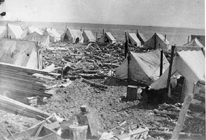As was so often the case in the opening of the American frontier, it took the
discovery of gold to get folks headed for Alaska. The gold rush gave many
communities in Alaska their start. Tent cities boasted all of the
necessities and suffered all of the hardships of boom towns.
It all began in 1872 near Sitka, on the Kenai Peninsula, and continued to
1914 when gold was discovered in Livengood near Fairbanks.
Alaska's first big gold strike came in Juneau in 1880 when two prospectors
guided by a Native found "large pieces of quartz, of black sulfite and galena
all spangled over with gold" in a creek that, of course, is now called Gold
Creek. On their initial trip they collected a thousand pounds of ore.
The first strike of any consequence on the
Alaskan side of the Yukon basin came in the autumn of 1886 on Fortymile River, a
Yukon tributary named by prospectors because its mouth was approximately 40
miles from the fur-trading post, Fort Reliance. Nuggets worth only about
50 cents a piece were reported, but the strike seemed promising enough to lure
prospectors from both up- and downriver the following spring.
In 1889, a man named King discovered gold nuggets in Resurrection Creek. More
prospectors rushed to stake claims. On a lark, the community of tents and cabins
that grew at the mouth of the creek chose to name their town after the youngest
rusher to step off the next boat. His name was Percy Hope....and the town name,
Hope,
became official. The surrounding area quickly swelled to 3,000 people.
A considerable find on Birch Creek in 1893 lured
additional miners. By 1896 more than 1,000 prospectors, including some
women, were in the Yukon basin on the Alaskan side of the border. The
great river and its tributaries had become a familiar highway network, allowing
travel by raft or steamer in summer, by dog sled or snowshoes in wither.
 |
|
Summer, 1900. Stampeders'
tents line the beaches of Nome. |
The discovery of gold at Anvil Creek in 1898 brought thousands of fortune
seekers - including Wyatt Earp - to the Nome area. In mid-spring,
the previously empty beaches west of Cape Nome had become a tent town of 250
people; by early summer the number had risen to 1,000 and by late summer
increased to 2,000. By the time it was all over, the newly discovered Cape
Nome mining district would see 20,000 stampeders on the beaches of Nome. It was
a spot where, a year earlier, there had been only a seasonal fishing camp.
Nome's boom was accompanied and followed by
strikes in different parts of Alaska: the Kenai Peninsula, Wiseman, Iditarod,
and the Tanana Valley, the last resulting in the founding of Fairbanks
on the Chena River, destined to become the largest town in
the interior. Felix Pedro, an Italian immigrant and former coal miner, is
credited with having made the initial discovery of gold in the valley in the
creek which today bears his name. Fairbanks became an important supply
post as well as a center of mining activity after gold was discovered in a creek
north of town in 1902.
Anchorage is the crossroads for Alaska where gold rush
adventurers met Russian and Native culture, and where a tent city in the
wilderness blossomed into the state’s largest city.
During the decade of 1890-1900, more than 30, 000 people surged into
Alaska and the Yukon Territory
when gold was discovered. Gold was never the
principal element of Alaska's enormous natural wealth, but it was beyond
question the catalyst that brought the huge, hitherto almost forsaken territory
to the attention of the world outside, and most particularly, to the belated
attention of the U.S. Congress, on whom its development depended.